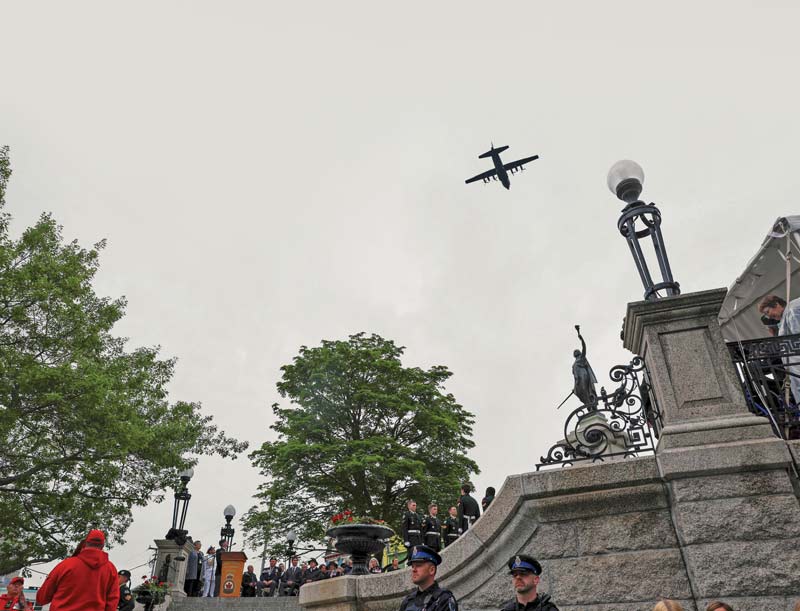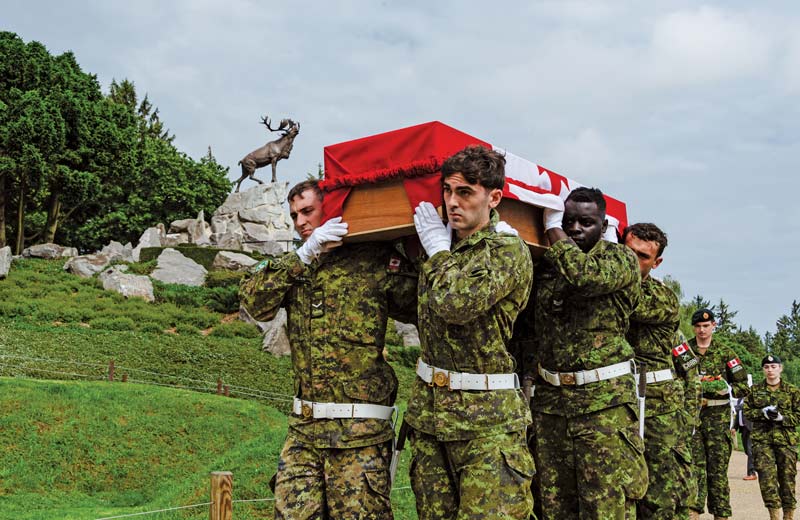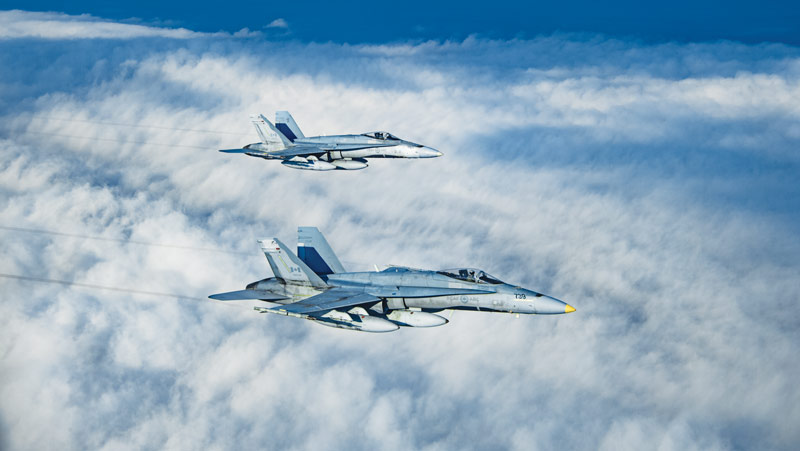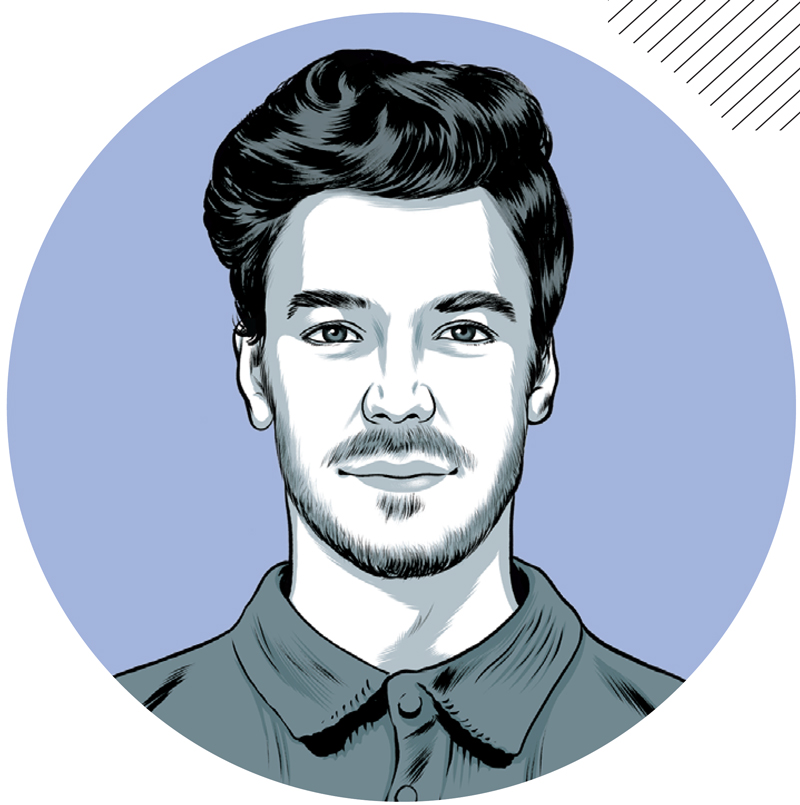
The Spirit of Newfoundland statue overlooks Memorial Day attendees. [Antoine Brochu/Canadian Forces Combat Camera]
While many in the country slept in, or prepared for a day of barbecuing, swimming and other quintessential Canada Day activities, Newfoundlanders and Labradorians mourned. Until noon, the last province to join Confederation continued a tragic 100-plus-year-old tradition of remembering their own war dead and observed the former self-governing island’s Memorial Day.
The 2024 parade and ceremony at the Newfoundland National War Memorial was historic. Not simply because it was the centennial of the monument’s unveiling, but because of something the people of the province had been waiting 108 years for. The day one of their own brothers, sons, fathers or uncles was brought home and put in his final resting place.
For the second time in Canada’s history, and the last time for a Commonwealth country, an unknown soldier was repatriated and placed in a tomb to represent all its war dead.
To understand the significance of Newfoundland bringing one of its own home, one must appreciate the magnitude the Battle of Beaumont-Hamel played in the history of the former British dominion and the influence it has on the province’s modern zeitgeist.
It is a mythological cloud that hangs over Newfoundlanders, shapes their understanding of who they are as a people, and their place in both British and Canadian history and hierarchy. Not one is spared from the scars that battle brought to the people of Newfoundland, even those generations removed. It has been said that Beaumont-Hamel is where Newfoundlanders learned to die. It may have even been foretelling of the death of a Newfoundland that wrote its own way.
At 7:30 a.m. on July 1, 1916, a co-ordinated attack against German lines began. The 1st Newfoundland Regiment started its attack at 9:15 a.m. By 9:45, the regiment had been almost wiped out. It had gone into battle with 801 men. The next day only 68 men answered roll call—255 had been killed, 386 were wounded and 91 were missing.

Newfoundland and Labrador Premier Andrew Furey, his wife Dr. Allison Furey and son Mark follow the unknown soldier’s casket after it arrived via government plane in St. John’s, N.L[Antoine Brochu/Canadian Forces Combat Camera]

Members of the Royal Newfoundland Regiment act as pallbearers at the Beaumont-Hamel Newfoundland Memorial in France. [Antoine Brochu/Canadian Forces Combat Camera]
From a population of about 240,000, more than 12,000 Newfoundlanders enlisted in the First World War, nearly 10 per cent of the dominion’s men, or 35.6 per cent of all males between 19 and 35 years old. Fatalities claimed between 1,281-1,305 of them. Another 2,284 were wounded. A generation of men gone—or forever changed. Men who could have raised families and been community leaders.
Falling into a deep state of emotional depression postwar, Newfoundland also faced an economic depression, which led to being the only dominion to give up self-governing status in 1934 and eventually joining Canada in 1949.
“I cannot identify this person and that’s the whole purpose of forensic anthropology: to return a face and identity to an individual.”
It was a long journey to fill the marble tomb in St. John’s below the bronzed lady known as the Spirit of Newfoundland. Originally, the idea was championed by Thomas Nangle, the Newfoundland Regiment’s padre during the First World War, in 1920. It was re-introduced seven years ago, when three Royal Canadian Legion members—Dominion First Vice Berkley Lawrence, Newfoundland and Labrador Command’s Second Vice Frank Sullivan and RCL spokesperson and historian Gary Browne—led an effort to refurbish the salt-weathered War Memorial that stands between Duckworth and Water streets in downtown St. John’s.
Sullivan, a veteran who served for 42 years in the regular and reserve forces, knew when he first suggested the idea of bringing home an unknown soldier there would be complicated work ahead. He contacted fellow Newfoundlander, MP Seamus O’Regan, who at the time was minister of veterans affairs. The federal government then worked with the French government and the Commonwealth War Graves Commission to obtain permission to repatriate the remains and plan the logistics of the transfer.
It took years to execute, and O’Regan said it was of the utmost importance “to get this done and bring him home with all the pomp and circumstance he deserves.”
So, when the unknown Newfoundland casualty of the Battle of Beaumont-Hamel was transferred from the French to the Canadian government in late May with more grand ceremony than he could have imagined, Sullivan was hit with a wave of emotions.
“Words fail me right now,” said the navy veteran. “It’s a moment that I’ll die with. What can I say? We’re bringing a son home; somebody’s son is coming home.”
Newfoundland and Labrador Premier Andrew Furey felt similarly. Accompanied by his wife and teenaged son, Furey acted as the soldier’s ceremonial next of kin.
“It’s incredibly moving, special, spiritual,” said Furey after the transfer ceremony. “To see the casket and to stand there with my son, realizing this is someone else’s son is incredibly emotional. I broke down several times.”

Royal Canadian Air Force CF-18s escort the unknown soldier back to St. John’s, N.L. [Antoine Brochu/Canadian Forces Combat Camera]
“The unknown soldier is a representation of everybody.”
The first step in bringing home an unknown soldier is deciding which grave to exhume. This work is done by historians who research the possible tombs and find ideal candidates.
“We had to be very careful as to which grave we exhumed to ensure the individual remains unknown,” said Sarah Lockyear, a Defence Department casualty identification co-ordinator. “Some of my colleagues work on projects trying to identify soldiers who are unknown Canadians. The last thing we wanted was to exhume somebody and then someone in the public does a research project and deduces who we chose.”
Still, enough identification work must be done to ensure the soldier was a Newfoundlander. Lockyear said they look at markers originally found with the body, such as cap badges and identification discs. They also match where the remains were found with records of missing soldiers from the same area.
Normally, Lockyear would then conduct genealogical research and analysis of the remains and archeological data to build a biological profile, which would ultimately lead to the individual’s date and place of birth and enough genetic markers to conduct DNA testing to uncover the individual’s exact identity.
However, in this case, she had to do the exact opposite. “There’s been conflicting emotions,” said Lockyear. “I cannot identify this person and that’s the whole purpose of forensic anthropology: to return a face and identity to an individual.”
Evidence found with the remains included a Newfoundland shoulder tab patch, boots and small pieces of textile from a uniform, all of which were where placed in the casket with the soldier.
Essentially, all that’s known about the unknown soldier is that he’s a Newfoundlander who fought and died in northern France while enlisted with the Newfoundland Regiment. His name is likely inscribed beneath the caribou monument at Beaumont-Hamel, alongside hundreds of others who died while fighting for the regiment.

The Memorial Day procession makes its way to the Newfoundland National War Memorial. [Antoine Brochu/Canadian Forces Combat Camera]

Pallbearers lower the unknown soldier into the tomb in downtown St. John’s.[Antoine Brochu/Canadian Forces Combat Camera]
A delegation of dignitaries, including former premier Dwight Ball, provincial and federal politicians, academics, Legion members and military officials, travelled to northern France for the transfer of the remains, which took place at the Beaumont-Hamel Newfoundland Memorial.
Members of the Royal Newfoundland Regiment, chosen by merit, were pallbearers and placed the unknown soldier under the caribou monument that stands over the rolling hills of the battlefield where so many men died. After a music- and poetry-filled ceremony, which left the delegation, public attending and some media members in tears, the Canadian flag-draped casket was carried into a hearse where it was driven to a government plane and escorted back to St. John’s by fighter jets. During the journey, people were hugging one another. Crying together. And congratulating each other for finally bringing their boy home.
When the unknown soldier was carried off the plane and into the hearse in St. John’s, the public lined the airport’s fences on the border of the runway to catch a glimpse and pay their respects. Others lined the streets as the procession moved past city landmarks.
Berdena Payne was one of those at the airport. Her husband was the military padre with the delegation, but she says she would have been there anyway.
“It’s pretty surreal. We don’t know how old he was, but after a hundred years, he’s finally home,” she said, fighting back tears. “A moment like this really hits home.”
A month later, the casket laid in state at the Confederation Building for three days, where thousands of people paid their respects. Officials had to extend viewing hours because of the numbers. A common question from those visiting the unknown soldier was why would a Canadian Flag be draped on the casket since he served under the Newfoundland Red Ensign and Newfoundland was a self-governing dominion of the British Empire during the First World War.
The military’s answer was that members of the Canadian Armed Forces can carry a casket draped only with a Canadian flag and not one of a specific province. Plus, in 1949, Canada assumed responsibility for all missing Newfoundland soldiers as if they were Canadian service members. Missing soldiers are still considered to be serving until they have been found.
When July 1 finally came and it was time to lay the unknown soldier to rest, the province came out. Humidity and light rain didn’t stop thousands of people from lining Water and Duckworth streets, filling Harbourside Park, standing on rooftops and poking their heads out of nearby windows to fulfil their vow of remembering Newfoundland’s fallen.
The ceremony was attended by Prime Minister Justin Trudeau, Governor General Mary Simon, Newfoundland and Labrador’s Lieutenant Governor Joan Marie J. Aylward, veterans and other dignitaries. The Royal Newfoundland Regiment’s band played, and The Ennis Sisters, a Legion choir and the Shallaway Youth Choir sang.
It was still early, but by the time Julia Penney, who lives just down the road came out, there was already a large crowd surrounding the memorial. She found a spot in the back of the park where she could watch the ceremony on a big screen.
“It’s a historic event and an important part of Newfoundland history,” said the St. John’s native. “So, I thought it was good to come out and support.”
Though she has no military connection she still felt a duty to attend. “Even if you don’t have a direct family history, everybody has some military connection to a degree,” said Penney. “The unknown soldier is a representation of everybody. Of all of our collective family. Maybe not literally, but symbolically, and I think that’s really important to celebrate.”
Someone who does have a direct connection and was in attendance was Paul Shea. “It’s most important I don’t miss this today,” he said. Shea comes to the Memorial Day event every year, rain or shine, to honour his great-uncle John Benjamin Ridgley, who served with the Newfoundland Regiment. He enlisted in 1916 shortly after Beaumont-Hamel. He went overseas and after being shot at Monchy-le-Pruex, died of his wounds in April 1917.
Now that the unknown soldier is at the memorial for eternity, said Shea, “we can pay our respects anytime we want.”
Advertisement



















